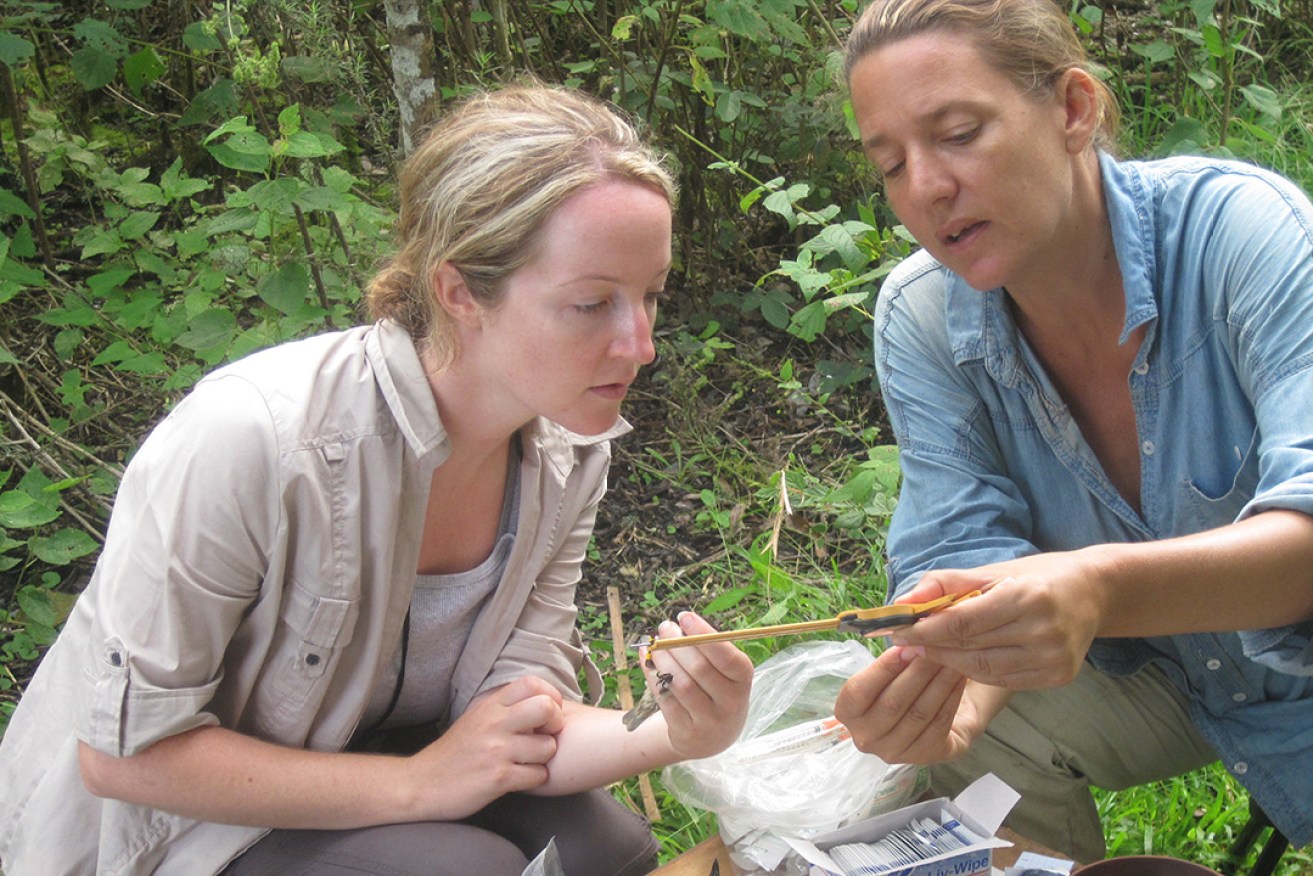
Animal scientists find trouble in Darwin’s paradise
A parasite killing Darwin’s finches on the famed Galápagos Islands is causing a dramatic escalation in survival-of-the-fittest behaviour once described by evolutionist Charles Darwin, new research has revealed.

Associate Professor Sonia Kleindorfer, right, measures a Darwin finch with fellow Flinders researcher Jody O'Connor in 2010. Photo Diane Colombelli-Negrel / Flinders University
After almost two decades of observing Galápagos finches, Flinders University bird expert Professor Sonia Kleindorfer and Macquarie University biological sciences researcher Dr Rachael Dudaniec have released a new paper summarising the impacts of the lethal introduced fly parasite Philornis downsi in the Pacific Ocean islands.
“The parasite, which was accidentally introduced into the Galápagos Islands circa 1960s, is now prevalent and increasing in number and the host finches are dying, with many threatened and locally extinct populations,” says Professor Kleindorfer, who leads Flinders’ Research Centre for Climate Adaptation and Animal Behaviour.
“The consequence of its introduction represents one of the most challenging conservation battles faced within host-parasite ecology today.
“As well, pollution from an exploding human population to service tourists is further degrading habitat, with high rainfall and turbulent weather destroying nesting events in recent years.
“However, the hope is that the birds will continue to evolve to cope with these stresses and one consequence of the fly infestation could be the emergence of changes in the parenting behaviour.”
Professor Kleindorfer says these apparently individual changes in beak morphology and bird song are likely to influence mate choice and henceforth the entire species’ fate.
“We hope this relationship can evolve into a sustained equilibrium where both species survive through shaping each other’s evolution, at least until conservation intervention can control the pest,” she says.
The long-term study by the Australian scientists has focused on the relationship between the invasive parasite and Darwin’s finches, and documents how it changed the evolutionary trajectory of these species in their struggle to co-evolve or perish in an epic battle of nature.
The parasitic fly, which may have been introduced by humans, is estimated to kill just over half of Darwin’s finch nestlings by consuming the blood and tissues of the developing birds.
This has caused a rapid decline in finch populations in the past 20 years but as more nestlings die, the parasite’s main food source also dies, leading to the death of the parasite larvae, too.
Through real-time video monitoring, the researchers have seen the birds respond by changing their parental care and nest-building behaviours to reduce infestations – and they have even seen genetic differences to the larvae infection develop in recent years.
In turn, the flies have also have adapted to the birds’ response by altering their reproductive cycle to lay eggs earlier and in a coordinated manner involving several females, which causes a more virulent infestation of the nestling.
The geographically remote Galápagos Islands became naturalist Charles Darwin’s ‘cradle of evolutionary thought’ after his 1835 visit. The Darwinian theory of evolution and natural selection was inspired by studying the migratory finches, mockingbirds, tortoises and other animals on the islands.
The adaptations observed in the latest study prompts broader evolutionary questions regarding the role of parasites as powerful evolutionary forces in nature.
Associate Professor Kleindorfer says the research will help inform how we conserve species across the globe – including Tasmania’s forty-spotted pardalote, which also is threatened by a parasitic fly similar to Philornis downsi.
There are fantastic examples of parasites manipulating host behaviour to achieve the goals of the parasite, such as ants that have been colloquially described as exercising “mind control” over their hosts, she says.
“Cows infested with lancet flukes defecate in grasslands, snails consume dung, fluke invades snail, snail excretes mucous with flukes, ant eats mucous, flukes change switch in ant brain to make ants seek sunlight at end of grass tips, cows eat ants on tips of grass blades. And the cycle continues [at a cost to the ant],” she explains.
“Many island extinctions are the result of introduced parasites, and there are many examples of parasites changing host behaviour or host morphology to the detriment of the host.”
The paper acknowledged the assistance of the Galápagos National Park, Charles Darwin Foundation (which supports the Philornis downsi Action Plan), Charles Darwin Research Station, Australian Research Council, Rufford Small Grant Foundation, Mohamed bin Zayed Species Conservation Fund, Max Planck Institute for Ornithology, Royal Society for the Protection of Birds Birdfair, Earthwatch Institute, Galápagos Conservation Fund, Australian Federation of University Women (SA) and field volunteers.
For full details, go to BMC Zoology




